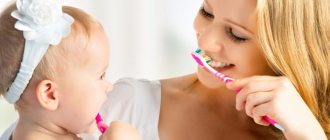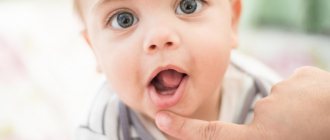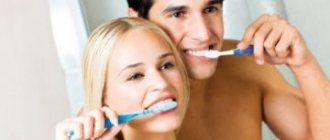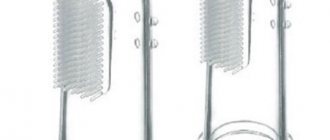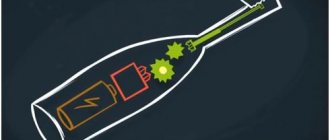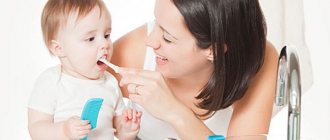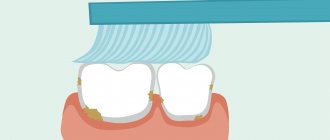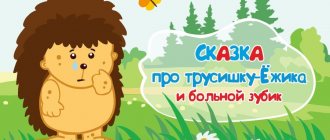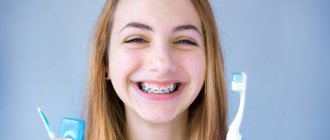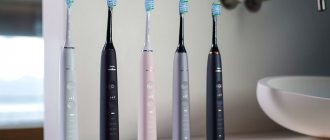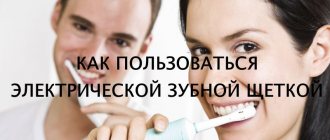Not all parents know how to properly brush their children’s teeth, but The condition of the erupted permanent teeth depends on the quality of care for baby teeth.
. To protect your child from problems with molars, incisors and canines, it is necessary to teach him to brush and rinse his mouth after the very first tooth erupts.
Features of the structure of milk teeth
Baby teeth form in the sixth week of fetal development. Normally there are 20 of them:
- 8 molars;
- 8 incisors;
- 4 fangs.
Temporary teeth consist of the same tissues as permanent teeth:
- dentin (in temporary teeth it is softer and less mineralized);
- enamels;
- pulp.
However, primary incisors, canines and molars have features:
- low crowns;
- large distance between crowns;
- long thin roots that dissolve before the temporary tooth falls out and the permanent tooth erupts;
- thin enamel - only 1 mm;
- wide channels.
The structure of baby teeth is only slightly different from permanent teeth, so they no less need proper care. You can start brushing your child’s teeth after the very first incisor has erupted.
. Early training in hygiene will be an excellent prevention against many dental diseases that can affect the primary incisors, and then the rudiments of the permanent ones formed under them.
If you don’t care for your baby’s teeth or care for them incorrectly, your baby will have to visit pediatric dentists already in the first three years of life. Or he may tolerate drilling rotted teeth with a bur, which is painful and unpleasant for a small child, even with high-quality anesthesia.
Subsequence
The order in which teeth appear may vary, which is rare and is not considered pathological. For some boys and girls, the upper incisors appear first, rather than the lower incisors as usual. But basically the sequence of teething in children is as follows (teeth appear in pairs):
- lower central incisors;
- upper central incisors;
- upper lateral incisors;
- lower lateral incisors;
- first upper molars (molars);
- first lower molars;
- upper canines;
- lower canines;
- second lower molars;
- second upper molars.
By the age of 2.5–3 years, the child has a full set of baby teeth: 10 on each jaw. After about 4–6 years, the roots begin to dissolve, the teeth lose support and fall out in the same order in which they erupted.
As the jaw and facial bones grow, spaces form between the primary teeth. This provides space for permanent, larger teeth to emerge, which erupt from 5 to 15 years of age.
How to properly clean a baby's mouth
Immediately after being discharged from the hospital, you need to start wiping the newborn baby’s gums with a thick gauze swab dipped in water. You can also wet the tampon in:
- chamomile infusion, if the baby does not have constipation;
- bactericidal infusion of sage;
- St. John's wort decoction, as this plant strengthens the gums;
- anti-inflammatory decoction of calendula.
It is not recommended to use decoctions and infusions of herbs to treat the oral cavity of a baby more than 2-3 times a week, as their abuse can lead to allergic reactions.
Maintaining hygiene, which involves treating the oral mucosa with a gauze swab, is necessary for both newborns who are breastfed and those children who are fed artificial formula. Breast milk does not clean the oral cavity, but pollutes it. If you do not sanitize your baby’s mouth after feeding, then pathogenic bacteria will begin to multiply in it, which can lead to infection of the tooth enamel.
At what age should a child start brushing his teeth?
You need to start brushing your baby's teeth from the moment they begin to erupt.
At first, it is better to perform manipulations without paste, carefully treating not only the first tooth, but also the gum itself. You can use a special soft baby brush or a silicone pad that is placed on the parent’s finger. The last device will serve not only as a brush, but also as a gum massager, which will ease the pain from teething.
You should act carefully during the cleaning process, since the gums near the cutting tooth are inflamed and painful, so infants may react poorly to the hygiene procedure. But you cannot refuse it: during teething, local immunity deteriorates, so the risk of infection of the enamel increases.
More details about caring for the oral cavity of a newborn are described in the video:
Main characteristics.
When choosing a brush for your baby, first of all you need to pay attention to the following: - a comfortable short handle - it will be much more convenient for your baby to control the brush; - soft bristles - tooth enamel is still too delicate and susceptible to abrasion, which is why the use of adult brushes is strictly contraindicated; - small head and cleaning surface - otherwise it will affect the quality of cleaning.
There is a very large selection of children's electric brushes here.
How to properly brush children's teeth
There are several general rules for high-quality teeth cleaning, depending on the age of the baby:
- A child under one year old should brush his teeth using a special silicone pad, which is fixed on the parent’s index or thumb.
- After a year, you can use a brush with silicone bristles and a special limiter, gradually switching to classic models.
- From the age of three, a regular brush with soft bristles is used. It is important that its surface is covered only by two dental crowns, otherwise the hygienic procedure will not be effective enough.
A baby brush needs to be changed every 3-4 months. If the service life has not yet expired, but the brush has already become rough around the edges, you should change it, since pathogenic bacteria can begin to form and multiply between the bristles.
How to brush the teeth of a child under 1 year old
Six months is the age when parents should start brushing their child’s teeth every day.
From 6 to 12 months, children are cutting teeth, so during this period it is necessary to sanitize their oral cavity very carefully. The baby cannot yet take part in the hygiene procedure, but can already express his dissatisfaction with sounds and gestures, so the adult should focus not only on the dental cleaning technique, but also on the baby’s sensations.
How to properly brush your first teeth
Key cleaning rules:
- the necessary movements should be sweeping: from the root to the top;
- the finger with the silicone attachment should be in the child’s mouth at an angle of 45 degrees to the gums;
- when processing chewing surfaces, the finger with the nozzle is positioned horizontally and cleans the crown with progressive longitudinal movements;
- The inner surface of the teeth is cleaned with short, quick movements;
- The side teeth can be cleaned using circular movements.
There should be about 10–15 movements per tooth. During the procedure, it is necessary to clean not only the dental enamel, but also the inner surface of the cheeks, tongue and gums. You can also brush your one-year-old child's teeth using special dental wipes, which can be purchased at the pharmacy.
Why you need to teach your child to brush their teeth earlier than one year
You should start brushing your baby's baby teeth when the first incisor appears or even before it fully erupts. Complete oral care will help:
- form the correct bite;
- It is good to clean the oral cavity from cariogenic bacteria;
- prevent various diseases, including caries.
How to brush teeth for children over one year old
A child over 1 year old can purchase their first toothbrush with silicone bristles. It costs more than a regular one, but such a waste of money is justified: a brush with silicone bristles will not injure the child’s teeth and will help to thoroughly clean the gums and cheeks. You can use it to clean even your child’s first teeth. However, such brushes quickly become unsuitable for safe use, so they should not be used for a long time.
Rules for caring for a children's toothbrush with silicone bristles
In order for the silicone brush to last longer, you must follow the following rules for its operation:
- Do not boil or even simply pour boiling water over the brush;
- After each use, you should wash it with soap (baby, tar, laundry).
The brush should not be placed in a case; it should be stored in a closed cabinet, in a glass, separately from the brushes of adult family members.
Toothpastes for one-year-old children and infants
To start brushing children's teeth using toothpaste, it is not necessary to wait until the child is one or three years old. Most toothpastes are indicated for children over 2 years of age, however, there are a number of manufacturers whose product lines include good fluoride-free toothpastes suitable for children under one year of age. They are completely harmless and can be swallowed. Such products can be found among the brands:
- ROCS
- Elmex.
- Splat.
- Lacalut.
Each toothpaste indicates at what age it is approved for use - you need to brush your child’s teeth only with a product that is not contraindicated for him and is suitable for comprehensive care of children’s teeth.
When starting to brush the teeth of a child under one year old using toothpaste, you need to monitor his reaction. Some babies may develop allergies, so at the first symptoms of a rash or an incomprehensible cough, you should stop using the paste and show your baby to a doctor.
Teeth brushing technique with toothpaste
You can start brushing your teeth with toothpaste when the child’s first incisor appears, the deadline is one and a half years.
You shouldn’t wait until he develops caries due to lack of proper care.
Brushing procedure with toothpaste:
- a certain amount of paste is applied to a pre-moistened brush;
- the brush is brought at a right angle to the crowns;
- The tooth surface must be cleaned using sweeping movements: from the roots to the tops;
- The inner dental surface is cleaned with short movements, the brush is placed at an angle of 45 degrees;
- the cutting and chewing surfaces of the crowns are processed at the very end;
- after completing the procedure, you should rinse your mouth with water;
- The approximate duration of each cleaning is 2–3 minutes.
2–3 years old is the age when you need to start teaching your child to brush their teeth on their own.
This tool will be very useful and effective if...
- The child has already reached 6 years of age.
- The child knows how to rinse his mouth and spit out the contents so as not to swallow any liquid accidentally found in the mouth.
- The rinse aid does not contain harmful components.
- The mouthwash is used for its intended purpose (for caries, for fresh breath, etc.).
- The procedure time does not exceed 30 seconds twice a day.
The site Colady.ru thanks you for your attention to the article! We will be very pleased if you share your feedback and tips in the comments below.
How to teach a child to brush their teeth
Many children under 1 year old, and sometimes older children, do not want to brush their teeth, expressing their dissatisfaction in every possible way. In this case, it is necessary to attract their attention to the hygiene procedure using one of the following methods:
- buy a bright brush with your favorite cartoon character and toothpaste with a pleasant fruity taste;
- invite your child to brush the teeth of his toys;
- brush your teeth with your child and compete with him in the quality and speed of brushing.
Each parent independently decides at what age to start brushing their child’s teeth and whether to use toothpaste, but delay can negatively affect the baby’s health. Parents should not only brush their children’s teeth, but also teach them how to properly care for their mouth on their own.
Dr. Komarovsky talks in more detail about children’s teeth, caring for them and teaching a child to brush:
What to focus on?
- For children up to 3 years old. Pastes for this age should not contain fluoride at all.
- For kids 3-4 years old. The fluorine content in pastes should not exceed 200 ppm, and the abrasive content (approx. RDA) should not exceed 20 units. There must be an inscription about the safety of the paste when swallowed (as for any paste “from 0 to 4”).
- For children 4-8 years old. In these pastes, the abrasiveness can reach 50 units, and the fluoride content can reach 500 ppm (but no more!). The paste may have anti-inflammatory properties and contain appropriate herbal ingredients. From the age of 6, you can add dental floss to your toothbrush, which you also need to teach your child to use.
- For children 8-14 years old. These pastes can already contain up to 1400 ppm of fluorine, but no more than 50 ppm of abrasive.
- From the age of 14, children can already use traditional versions of adult toothpaste.
